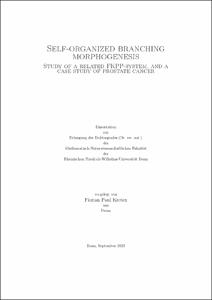Self-organized branching morphogenesisStudy of a related FKPP-system, and a case study of prostate cancer

Self-organized branching morphogenesis
Study of a related FKPP-system, and a case study of prostate cancer

| dc.contributor.advisor | Bovier, Anton | |
| dc.contributor.author | Kreten, Florian Paul | |
| dc.date.accessioned | 2024-01-03T10:03:25Z | |
| dc.date.available | 2025-01-15T23:00:51Z | |
| dc.date.issued | 03.01.2024 | |
| dc.identifier.uri | https://hdl.handle.net/20.500.11811/11216 | |
| dc.description.abstract | The group of E. Hannezo et al. proposed "A Unifying Theory of Branching Morphogenesis" in glandular epithelial tissues in 2017, based on a stochastic model related to branching and annihilating random walks. In this stochastic model, the individual branches of a tree-like structure grow and branch independently. A hard-coded self-avoiding mechanism makes an analytic treatment of the stochastic model challenging.
In the first part of this PhD thesis, we investigate a related PDE which describes the evolution of two densities of particles: The so-called active particles diffuse and branch and become inactive upon collision with a particle of arbitrary type. The inactive particles do not react and are of low diffusivity. In the absence of active particles, this system is in a steady state, irrespectively of the inactive particles. The resulting continuum of non-hyperbolic steady states complicates the analysis of the PDE. We construct the non-negative traveling waves of the PDE and show that they share many similarities with those of the classical FKPP-equation. Among the constructed pulled heteroclinic waves, those with minimal possible speed – referred to as critical – are of particular relevance. Subject to compact initial data, simulations of the PDE always show the same behavior: The front of the solution converges to the critical traveling wave. We then show that the critical traveling waves are asymptoticly stable. To overcome the problem that the limits of the traveling waves are not hyperbolic, we operate in a weighted space where the perturbations can grow exponentially at the back of the wave, but vanish point-wise, a phenomenon referred to as convective stability. We present a new type of a-priori estimate, based on a Feynman-Kac formula, for controlling the unbounded nonlinear terms of the perturbation equation. Our results for the PDE correspond to the phenomena which are found numerically for the stochastic model. In the second part of this thesis, we investigate the growth and the clonal evolution of prostate adeconarcinoma (PCA). These tumors form branched self-avoiding structures, we hypothesize that their growth follows the rules for branching morphogenesis formulated by Hannezo et al. We formulate a mathematical model for the growth and the stochastic genotypic evolution of PCA. Via simulations, we explore in detail the possible evolutionary patterns and clonal architectures, and demonstrate that the tumour architecture represents a major bottleneck for a divergent clonal evolution. As a result, we hypothesize that strong genomic driver mutations cause the evolution of the tumors into more aggressive variants, contrasting the idea of a gradual, continuous evolution. We validate the results of our simulations using multiregional next generation DNA sequencing of the primary tumours from five patients, and find close similarities between our predictions of clonal development and real-world data from the patient samples. | en |
| dc.language.iso | eng | |
| dc.rights | Namensnennung 4.0 International | |
| dc.rights.uri | http://creativecommons.org/licenses/by/4.0/ | |
| dc.subject | Traveling waves | |
| dc.subject | Convective stability | |
| dc.subject | FKPP-System | |
| dc.subject | Branched Growth | |
| dc.subject | Self-organization | |
| dc.subject | Prostate Cancer | |
| dc.subject.ddc | 510 Mathematik | |
| dc.title | Self-organized branching morphogenesis | |
| dc.title.alternative | Study of a related FKPP-system, and a case study of prostate cancer | |
| dc.type | Dissertation oder Habilitation | |
| dc.identifier.doi | https://doi.org/10.48565/bonndoc-193 | |
| dc.publisher.name | Universitäts- und Landesbibliothek Bonn | |
| dc.publisher.location | Bonn | |
| dc.rights.accessRights | openAccess | |
| dc.identifier.urn | https://nbn-resolving.org/urn:nbn:de:hbz:5-73614 | |
| dc.relation.arxiv | 2305.10228 | |
| dc.relation.doi | https://doi.org/10.1007/s00285-022-01753-z | |
| ulbbn.pubtype | Erstveröffentlichung | |
| ulbbnediss.affiliation.name | Rheinische Friedrich-Wilhelms-Universität Bonn | |
| ulbbnediss.affiliation.location | Bonn | |
| ulbbnediss.thesis.level | Dissertation | |
| ulbbnediss.dissID | 7361 | |
| ulbbnediss.date.accepted | 16.11.2023 | |
| ulbbnediss.institute | Mathematisch-Naturwissenschaftliche Fakultät : Fachgruppe Mathematik / Institut für angewandte Mathematik | |
| ulbbnediss.fakultaet | Mathematisch-Naturwissenschaftliche Fakultät | |
| dc.contributor.coReferee | Velázquez, Juan | |
| ulbbnediss.contributor.orcid | https://orcid.org/0000-0003-1938-2590 | |
| ulbbnediss.date.embargoEndDate | 15.01.2025 |
Dateien zu dieser Ressource
Das Dokument erscheint in:
-
E-Dissertationen (4337)




